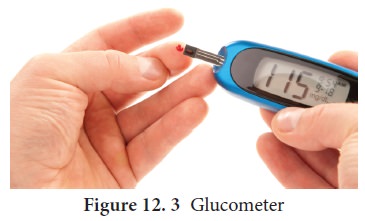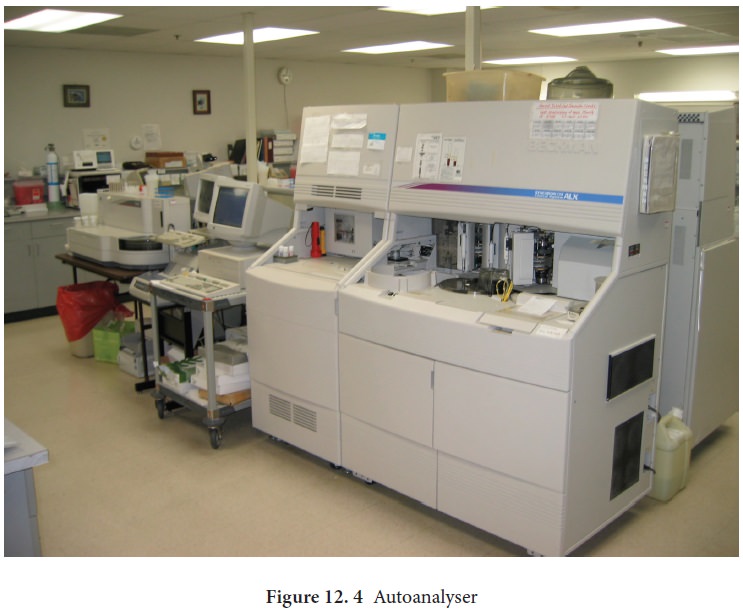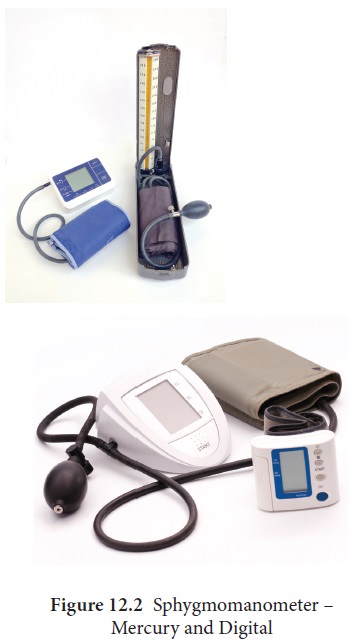Chapter: 11th Zoology : Chapter 12 : Basic Medical Instruments and Techniques
Diagnostic and Monitoring Instruments
Diagnostic and Monitoring Instruments
Stethoscope
Stethoscope is a medical device used to hear the
internal sounds of the human body such
as heart beat,
sounds due to
inhalation and exhalation
of air in
the lungs, stomach, intestinal
movements and also foetal movements. The modern electronic stethoscope is a
high precision instrument used to hear with clarity the internal sounds of the
human body even in a noisy environment or through the heavy clothing of the patient.
A typical stethoscope consists of a disc shaped resonator that is placed
against chest with two rubber tubes connected to earpieces. This is
simply known as binaural stethoscope. It is a simple but an effective
diagnostic tool to localize problems and to diagnose diseases (Figure12.1).

Clinical significance of stethoscope
1.
Stethoscope helps to find the normal and abnormal
heart beat sounds and also to diagnose valve functions.
2.
It helps to diagnose lung diseases such as
pneumonia, pulmonary edema, bronchitis and pleuritis.
3.
Stethoscopes along with sphygmomanometer are used
to read the blood pressure.
4.
It outlines the status of cardiac, respiratory and
intestinal disorders.
Sphygmomanometer
Sphygmomanometer is a device that measures the
blood pressure hence known as blood pressure meter, blood pressure monitor or
blood pressure gauge. It consists of a rubber cuff which is wrapped around the
upper arm and the other end is connected to a mercury manometer which directly
measures the pressure in a uniformly graduated scale ((Figure12.2).
By gradually increasing and reducing the pressure
in the cuff, the systolic and diastolic blood pressure is clearly monitored by
the sounds of arterial blood flow. The cuff is smoothly wrapped around the
upper arm 3 cm above the elbow. The resonator of the stethoscope is placed on
the brachial artery at the elbow to hear the blood flow sounds. The cuff is
then rapidly inflated to 180 mm Hg and is then slowly deflated. As the pressure
in the cuff falls a “whooshing” sound is heard then the blood flow starts again
in the artery. This indicates the patient’s systolic pressure. Then the
pressure is slowly released until no sound is heard. This is measured as the
diastolic blood pressure. For better clinical understanding readings may be
taken in both arms.
Types of sphygmomanometer
1.Manual sphygmomanometer
a. Mercury
sphygmomanometer: It shows blood pressure by affecting the height of
a column of mercury which does not
require calibration.
b. Aneuroid
sphygmomanometer: It is a mechanical type with a dial and it
requires calibration checks unlike
mercury manometer.
2.Digital sphygmomanometer:
It detects systolic and diastolic pressures by an oscillometric detector. It is easy to use even without training.
The maximum pressure exerted during the ventricular
contraction is called systolic pressure and the minimum pressure
exerted during the ventricular relaxation is called diastolic pressure.
Normal Blood Pressure = 120/80 mmHg
Systolic pressure = 120 mm Hg
Diastolic pressure = 80 mm Hg
Clinical Significance
1. To
diagnose pathological conditions such as hypertension and hypotension
2. Helps to
assess the state of blood circulation.
3. Provides
the functional details of heart.
Glucometer
Glucometer is a simple and portable medical device used to record the approximate levels of blood glucose. It is a battery operated digital meter. A drop of blood is taken from the tip of the finger and placed on the disposable test strip. The meter reads the blood sample and displays the glucose level in the units of mg/dL. Most glucometers are based on the electrochemical technology or colour reflectance principle (Figure12.3).

Significance
1.
Handy and portable
2.
Immediate results, the results are displayed in
approximately 40 seconds.
3.
Requires no calculation
4.
No training is required for operating the
instrument
Normal Glucose Values in blood
Normal glucose value: 70 – 100 mg/dL
Random blood sugar: 80 – 120 mg/dL
Fasting blood sugar: 70 – 110 mg/dL
Post – prandial blood sugar: 70 – 140mg/dL
Autoanalyser
Autoanalyser is a computer controlled device. It is used for quick estimation of several bio -chemical parameters like glucose, urea, cholesterol, enzymes and other proteins present in body fluids. The analyser is fully integrated with all the necessary controls such as temperature of reaction, volumes of sample, reagents and transfer of fluids. More sophisticated multichannel autoanalysers with capabilities of selecting any type of analysis for any one set of samples are available now (Figure12.4).

Related Topics
